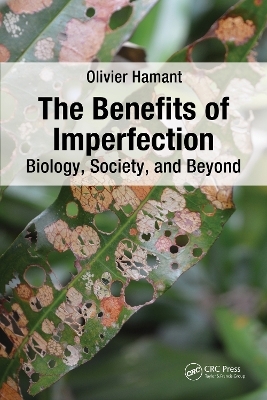
The Benefits of Imperfection
CRC Press (Verlag)
978-1-032-83220-3 (ISBN)
The cult of performance leads our society to emphasise the values of success and continuous optimisation in all areas. Slowness, redundancy and randomness are therefore negatively perceived. Olivier Hamant, in his book, reclaims them by his knowledge of biological processes.
What can we learn from life sciences? While some biological mechanisms certainly boast formidable efficiency, recent advances instead highlight the fundamental role of errors, incoherence or slowness in the robustness of living organisms. Should life be considered suboptimal? To what extent could suboptimality become a counter-model to the credo of performance and control in the Anthropocene?
In the face of pessimistic observations and environmental alerts, the author outlines solutions for a future that is viable and reconciled with nature.
Key Features:
Solidly documents with a grounding in scientific facts focusing on solutions
Explores a pragmatic way towards robustness, moving the debate beyond performance, technolatry or degrowth
Responds to eco-anxiety by providing an engaging and viable way forward
Olivier Hamant is a researcher at the French National Research Institute for Agriculture, Food and Environment (Institut National de Recherche pour l’Agriculture, l’Alimentation et l’Environnement, INRAE) at École Normale Supérieure de Lyon. As an interdisciplinary biologist, he has published approximately 100 scientific articles, notably on the development of plants and their ability to perceive their own shape. He also heads the Michel Serres Institute and is involved in training programmes on the new relationship between humanity and nature. As an independent author, he published La Troisième Voie du Vivant (Odile Jacob, 2022) / The Benefits of Imperfection (CRC Press, 2025), Antidote to the Cult of Performance (Gallimard, 2023) and De l'Incohérence (Odile Jacob, 2024, untranslated).
1. Preamble, as an executive summary. 2. The Age of Performance. 3. Which Third Way? 4. Suboptimality. 5. Robustness of Life. 6. A Counter-Model. 7. Some Chronological Reference Points. 8. Acronyms and Abbreviations. 9. References.
| Erscheinungsdatum | 18.09.2024 |
|---|---|
| Verlagsort | London |
| Sprache | englisch |
| Maße | 156 x 234 mm |
| Gewicht | 503 g |
| Themenwelt | Sachbuch/Ratgeber ► Natur / Technik ► Natur / Ökologie |
| Naturwissenschaften ► Biologie ► Botanik | |
| Naturwissenschaften ► Geowissenschaften ► Geologie | |
| Weitere Fachgebiete ► Land- / Forstwirtschaft / Fischerei | |
| ISBN-10 | 1-032-83220-7 / 1032832207 |
| ISBN-13 | 978-1-032-83220-3 / 9781032832203 |
| Zustand | Neuware |
| Informationen gemäß Produktsicherheitsverordnung (GPSR) | |
| Haben Sie eine Frage zum Produkt? |
aus dem Bereich


